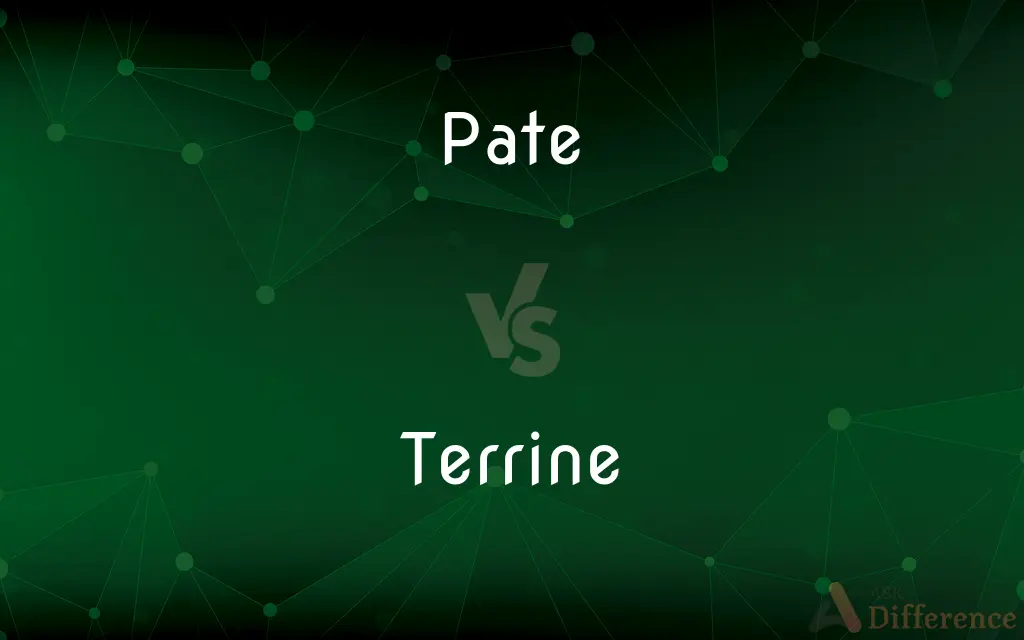Pate vs. Terrine — What's the Difference?
By Maham Liaqat & Urooj Arif — Updated on May 17, 2024
Pâté is a finely ground mixture of meat, liver, and other ingredients, often spreadable, while terrine is a coarser, chunkier preparation of similar ingredients, typically baked in a loaf-shaped dish and sliced for serving.

Difference Between Pate and Terrine
Table of Contents
ADVERTISEMENT
Key Differences
Pâté is a type of meat paste made from a combination of ground meat, liver, and often other ingredients like spices, herbs, and wine. It is smooth, spreadable, and can be served either hot or cold. Terrine, on the other hand, refers to both the dish and the preparation method. It is a coarser, more textured mixture of meats and other ingredients, often including chunks of meat, vegetables, and herbs.
Pâté can be presented in various forms, such as pâté de campagne (country pâté) or pâté en croûte (in a pastry crust). Terrines are usually baked in a rectangular or loaf-shaped dish (also called a terrine) and served cold in slices. They may also include layers of different ingredients for a more complex presentation.
While both pâté and terrine are traditional French charcuterie items, pâté is typically smoother and spreadable, ideal for spreading on bread or crackers. Terrine is chunkier and more solid, making it suitable for slicing and serving as part of a platter.
Comparison Chart
Texture
Smooth, spreadable
Coarser, chunkier
Preparation
Ground meat and liver, finely mixed
Coarser mixture with chunks of meat and vegetables
ADVERTISEMENT
Serving Method
Spreadable, can be served hot or cold
Sliced, usually served cold
Dish Type
Various forms, such as pâté de campagne
Baked in a loaf-shaped dish
Presentation
Often spread on bread or crackers
Sliced and served on a platter
Compare with Definitions
Pate
A smooth, spreadable meat paste.
The pâté was served on toasted baguette slices as an appetizer.
Terrine
Baked in a loaf-shaped dish.
The terrine was baked in a rectangular dish and chilled before serving.
Pate
Made from ground meat, liver, and other ingredients.
The chef prepared a rich chicken liver pâté.
Terrine
A coarser, chunkier meat mixture.
The terrine was sliced and served with pickles and mustard.
Pate
Often includes spices, herbs, and wine.
The duck pâté was flavored with thyme and port wine.
Terrine
Typically includes chunks of meat and vegetables.
The rabbit terrine had visible pieces of rabbit and pistachios.
Pate
See paste1.
Terrine
Can include layered ingredients.
The terrine had alternating layers of pork and veal.
Pate
The human head, especially the top of the head
A bald pate.
Terrine
Served cold, often sliced.
The cold terrine slices were arranged on a charcuterie board.
Pate
The mind or brain.
Terrine
An earthenware container for cooking and serving food.
Pate
A meat paste, such as pâté de foie gras.
Terrine
Any of various dishes prepared or cooked in a terrine.
Pate
A similar paste made of seasoned vegetables.
Terrine
A deep type of dish or pan, typically used for casseroles and made out of pottery.
Pate
A small pastry filled with meat or fish.
Terrine
A pâté baked in such a dish and served cold.
Pate
The head, particularly the top or crown.
He had a shiny, bald pate.
Terrine
A dish or pan, originally of earthenware, such as those in which various dishes are cooked and served; esp., an earthenware jar containing some table delicacy and sold with its contents.
Pate
(archaic) Wit, cleverness, cognitive abilities.
Terrine
A kind of ragout formerly cooked and served in the same dish; also, a dish consisting of several meats braised together and served in a terrine.
Pate
Alternative spelling of pâté(finely-ground paste of meat, fish, etc.)
Terrine
A soup tureen.
Pate
The interior body, or non-rind portion of cheese, described by its texture, density, and color.
Terrine
A pate or fancy meatloaf baked in an earthenware casserole
Pate
See Patté.
Pate
A pie. See Patty.
Pate
A kind of platform with a parapet, usually of an oval form, and generally erected in marshy grounds to cover a gate of a fortified place.
Pate
The head of a person; the top, or crown, of the head.
His mischief shall return upon his own head, and his violent dealing shall come down upon his own pate.
Fat paunches have lean pate.
Pate
The skin of a calf's head.
Pate
Liver or meat or fowl finely minced or ground and variously seasoned
Pate
The top of the head
Pate
Can be served hot or cold.
The warm pâté en croûte was a hit at the dinner party.
Pate
Used as a spread for bread or crackers.
Guests enjoyed spreading the pâté on crusty bread.
Common Curiosities
What is pâté?
Pâté is a smooth, spreadable paste made from ground meat, liver, and other ingredients.
What is terrine?
Terrine is a coarser meat mixture baked in a loaf-shaped dish and typically served sliced.
How is terrine typically served?
Terrine is typically sliced and served on a platter.
Is terrine always served cold?
Yes, terrine is typically served cold, sliced.
What ingredients are common in terrine?
Terrine often includes chunks of meat, vegetables, and sometimes layers of different ingredients.
Is terrine a French dish?
Yes, terrine is also a traditional French charcuterie item.
How is pâté different from terrine?
Pâté is smooth and spreadable, while terrine is chunkier and more solid.
Is pâté a French dish?
Yes, pâté is a traditional French charcuterie item.
Can pâté be served hot?
Yes, pâté can be served hot or cold.
Can terrine include liver?
Yes, terrine can include liver along with other meats and ingredients.
Can pâté include vegetables?
Yes, pâté can include vegetables as part of the mixture.
Can terrine be layered?
Yes, terrines can include layers of different ingredients for a more complex presentation.
What ingredients are common in pâté?
Pâté commonly includes ground meat, liver, spices, herbs, and wine.
How is pâté typically served?
Pâté is usually spread on bread or crackers.
Can pâté be made from different meats?
Yes, pâté can be made from various meats such as pork, duck, or chicken.
Share Your Discovery

Previous Comparison
Neanderthal vs. Troglodyte
Next Comparison
Shallow vs. VainAuthor Spotlight
Written by
Maham LiaqatCo-written by
Urooj ArifUrooj is a skilled content writer at Ask Difference, known for her exceptional ability to simplify complex topics into engaging and informative content. With a passion for research and a flair for clear, concise writing, she consistently delivers articles that resonate with our diverse audience.












































